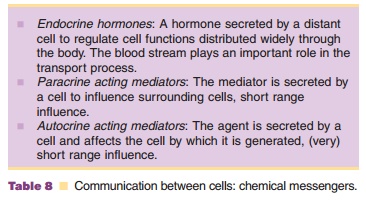Chapter: Pharmaceutical Biotechnology: Fundamentals and Applications : Formulation of Biotech Products, Including Biopharmaceutical Considerations
Delivery of Proteins: By The Parenteral Route
DELIVERY OF PROTEINS: APPROACHES FOR RATE-CONTROLLED AND TARGET SITE-SPECIFIC DELIVERY BY THE PARENTERAL ROUTE
Presently used therapeutic proteins widely differ in their pharmacokinetic characteristics. If they are endogenous agents such as insulin, t-PA, growth hormone, erythropoetin, interleukins or factor VIII, it is important to realize why, when and where they are secreted. There are three different ways in which cells can communicate with each other: the endocrine, paracrine, and autocrine pathway (Table 8).

The dose–response relationship of these media-tors is often not S-shaped, but, for instance, bell shaped: at high doses the therapeutic effect disap-pears. Moreover, the presence of these mediators may activate a complex cascade of events that needs to be carefully controlled. Therefore, key issues for their therapeutic success are: (i) access to target cells, (ii) retention at the target site, and (iii) proper timing of delivery (Tomlinson, 1987).
In particular, for paracrine and autocrine acting proteins, site-specific delivery can be highly desirable, because otherwise side effects will occur outside the target area. Severe side effects were reported with cytokines, such as tumor necrosis factor and interleu-kin-2 upon parenteral (IV or SC) administration. The occurrence of these side effects limits the therapeutic potential of these compounds. Therefore, the delivery of these proteins at the proper site, rate, and dose is a crucial part in the process of the design and development of these compounds as pharmaceutical entities. The following sections discuss first concepts developed to control the release kinetics and subse-quently concepts for site-directed drug delivery.
Related Topics